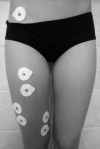Kinesiology Taping does not Modify Electromyographic Activity or Muscle Flexibility of Quadriceps Femoris Muscle: A Randomized, Placebo-Controlled Pilot Study in Healthy Volleyball Players
- PMID: 26232122
- PMCID: PMC4527115
- DOI: 10.12659/MSM.894150
Kinesiology Taping does not Modify Electromyographic Activity or Muscle Flexibility of Quadriceps Femoris Muscle: A Randomized, Placebo-Controlled Pilot Study in Healthy Volleyball Players
Abstract
Background: Kinesiology taping (KT) is a popular method of supporting professional athletes during sports activities, traumatic injury prevention, and physiotherapeutic procedures after a wide range of musculoskeletal injuries. The effectiveness of KT in muscle strength and motor units recruitment is still uncertain. The objective of this study was to assess the effect of KT on surface electromyographic (sEMG) activity and muscle flexibility of the rectus femoris (RF), vastus lateralis (VL), and vastus medialis (VM) muscles in healthy volleyball players.
Material and methods: Twenty-two healthy volleyball players (8 men and 14 women) were included in the study and randomly assigned to 2 comparative groups: "kinesiology taping" (KT; n=12; age: 22.30 ± 1.88 years; BMI: 22.19 ± 4.00 kg/m(2)) in which KT application over the RF muscle was used, and "placebo taping" (PT; n=10; age: 21.50 ± 2.07 years; BMI: 22.74 ± 2.67 kg/m(2)) in which adhesive nonelastic tape over the same muscle was used. All subjects were analyzed for resting sEMG activity of the VL and VM muscles, resting and functional sEMG activity of RF muscle, and muscle flexibility of RF muscle.
Results: No significant differences in muscle flexibility of the RF muscle and sEMG activity of the RF, VL, and VM muscles were registered before and after interventions in both groups, and between the KT and PT groups (p>0.05).
Conclusions: The results show that application of the KT to the RF muscle is not useful to improve sEMG activity.
Figures




Similar articles
-
Effect of kinesiology tape application direction on quadriceps strength.Medicine (Baltimore). 2018 Jun;97(24):e11038. doi: 10.1097/MD.0000000000011038. Medicine (Baltimore). 2018. PMID: 29901599 Free PMC article. Clinical Trial.
-
Kinesio Taping(®) does not alter neuromuscular performance of femoral quadriceps or lower limb function in healthy subjects: randomized, blind, controlled, clinical trial.Man Ther. 2013 Feb;18(1):41-5. doi: 10.1016/j.math.2012.06.009. Epub 2012 Jul 15. Man Ther. 2013. PMID: 22796389 Clinical Trial.
-
Assessment of the Impact of Kinesiology Taping Application Versus Placebo Taping on the Knee Joint Position Sense. Preliminary Report.Ortop Traumatol Rehabil. 2018 Apr 30;20(2):139-148. doi: 10.5604/01.3001.0012.0425. Ortop Traumatol Rehabil. 2018. PMID: 30152782
-
Linearity and reliability of the EMG amplitude versus dynamic torque relationships for the superficial quadriceps femoris muscles.Electromyogr Clin Neurophysiol. 2010 Mar;50(2):97-106. Electromyogr Clin Neurophysiol. 2010. PMID: 20405785 Clinical Trial.
-
Influence of pelvic padding and Kinesiology Taping on pain perception, kinematics, and kinetics of falls in female volleyball athletes.Gait Posture. 2018 Jul;64:25-29. doi: 10.1016/j.gaitpost.2018.05.024. Epub 2018 May 22. Gait Posture. 2018. PMID: 29807269
Cited by
-
Effects of Kinesio Taping and Rigid Taping on Gluteus Medius Muscle Activation in Healthy Individuals: A Randomized Controlled Study.Int J Environ Res Public Health. 2022 Nov 12;19(22):14889. doi: 10.3390/ijerph192214889. Int J Environ Res Public Health. 2022. PMID: 36429610 Free PMC article. Clinical Trial.
-
Acute Effects of Kinesio Taping on Functional Performance in Healthy Soccer Players: A Randomized, Controlled Crossover Trial.J Funct Morphol Kinesiol. 2022 Dec 20;8(1):2. doi: 10.3390/jfmk8010002. J Funct Morphol Kinesiol. 2022. PMID: 36648894 Free PMC article.
-
Does the Direction of Kinesiology Tape Application Influence Muscle Activation in Asymptomatic Individuals?Int J Sports Phys Ther. 2021 Feb 1;16(1):135-144. doi: 10.26603/001c.18799. Int J Sports Phys Ther. 2021. PMID: 33604143 Free PMC article.
-
Kinesiology Taping Does Not Affect Tarsal Joint Motion During Selected Exercises in Dogs.Vet Sci. 2025 May 3;12(5):439. doi: 10.3390/vetsci12050439. Vet Sci. 2025. PMID: 40431532 Free PMC article.
-
The Effect of Kinesio Taping Applied to Quadriceps and Gastrocnemius Muscles on Speed, Agility and Flexibility: A Cross-Sectional Study.J Musculoskelet Neuronal Interact. 2023 Dec 1;23(4):417-425. J Musculoskelet Neuronal Interact. 2023. PMID: 38037360 Free PMC article.
References
-
- Cools AM, Witvrouw EE, Danneels LA, Cambier DC. Does taping influence electromyographic muscle activity in the scapular rotators in healthy shoulders? Man Ther. 2002;7:154–62. - PubMed
-
- Ozer D, Senbursa G, Baltaci G, Hayran M. The effect on neuromuscular stability, performance, multi-joint coordination and proprioception of barefoot, taping or preventative bracing. Foot. 2009;19:205–10. - PubMed
-
- González-Iglesias J, Fernández-de-Las-Peñas C, Cleland JA, et al. Short-term effects of cervical kinesio taping on pain and cervical range of motion in patients with acute whiplash injury: a randomized clinical trial. J Orthop Sports Phys Ther. 2009;39:515–21. - PubMed
-
- Kase K, Wallis J, Kase J. Clinical therapeutic applications of the kinesio tapping method. 2nd ed. Tokyo, Japan: Ken Kai Co; 2003.
Publication types
MeSH terms
Substances
LinkOut - more resources
Full Text Sources

